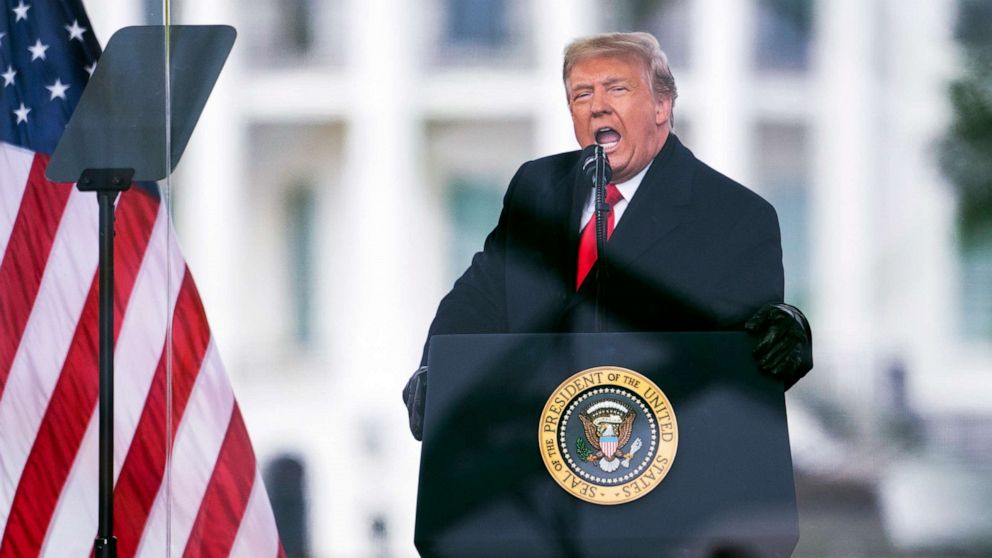针对前总统唐纳德·特朗普(Donald Trump)的起诉书提到了与特朗普一起采取行动的其他六名“共谋者”,但没有指名道姓。
根据起诉书中的信息和公开信息,ABC News已确定其中五名共谋者可能是以下个人:

在这张2021年1月6日的资料照片中,唐纳德·特朗普总统在华盛顿特区抗议选举团认证乔·拜登为总统的集会上发表讲话..
Evan Vucci/AP,文件
同谋1:鲁迪·朱利安尼
起诉书将这名共谋者描述为“一名律师,他愿意传播明知故犯的虚假主张,并采取被告2020年连任竞选律师不会采取的策略。”
具体而言,起诉书称,正是特朗普和这名同谋打电话给众议院议长拉斯蒂·鲍尔斯(Rusty Bowers),要求他在假选举人问题上“利用立法机关绕过程序”。在对话中,这位共谋者说了一些大意如下的话,“我们没有证据,但我们有很多理论。”[第10页]
鲍尔斯在1月6日给委员会的证词中公开叙述了这次谈话,并指名鲁迪·朱利安尼为说这话的人。
共谋者2:约翰·伊斯曼
起诉书将这名共谋者描述为“一名律师,他设计并试图实施一项战略,利用副总统监督认证程序的礼仪角色来阻挠总统选举的认证。”
在一个具体的例子中,起诉书指控川普和这名共谋者打电话给RNC的女主席,以“确保该计划正在进行中”,在电话中,这名共谋者告诉她,“RNC帮助被告的竞选活动在目标州收集选举人是重要的,并向她虚假地表示,只有在其中一个州正在进行的诉讼改变了有利于被告的结果时,才会使用这些选举人的选票。"[第23页]
根据听证会上播放的一个片段,RNC主席罗娜·麦克丹尼尔(Ronna McDaniel)在1月6日委员会作证时说,特朗普给她打了电话,“他把电话转给了伊斯曼,然后伊斯曼接着谈到帮助竞选团队聚集这些临时选民的重要性,以防正在进行的任何法律挑战改变任何州的结果。”
同谋3:西德尼·鲍威尔
起诉书将这名同谋描述为“一名律师,被告私下向他人承认的选举欺诈指控毫无根据,听起来很疯狂”。起诉书继续写道:“尽管如此,被告接受并公开放大了共谋者3的虚假信息。”。
根据1月6日委员会的最终报告,霍普·希克斯作证说,特朗普和鲍威尔在新闻发布会后通了电话,期间她“重复了她在新闻发布会上对外国干涉选举的相同说法”据报道,在那次通话中,“特朗普静音了他的扬声器,嘲笑了鲍威尔,”并告诉房间里的人“这听起来很疯狂,不是吗?”
同谋4:杰弗里·克拉克
起诉书将这名同谋描述为“一名从事民事工作的司法部官员,他与被告一起,试图利用司法部开展虚假的选举犯罪调查,并以明知故犯的选举欺诈指控影响州立法机构。”
这可能是杰弗里·克拉克(Jeffrey Clark),他是特朗普任命的司法部官员,在2020年大选前几周,他被任命为司法部民事部门的代理负责人。
根据起诉书,“共谋者4”在1月6日之前秘密会见了特朗普几次,他“试图胁迫”代理司法部长和代理副总检察长签署一份给乔治和其他州的信草案,谎称司法部“已经确定了可能影响多个州选举结果的重大问题”,他甚至接受了特朗普的提议,以代理司法部长的身份接管司法部——特朗普最终放弃了这一举动。
虽然起诉书只写了“第四共谋者”,但1月6日的委员会报告包括了信件草案中的一些相同内容(起诉书第28页),并指名道姓地指出克拉克是起草者之一。
共谋者5:肯尼斯·切塞布罗
起诉书将这名共谋者描述为“一名律师,他协助设计并试图实施一项计划,提交欺诈性的总统选举人名单,以阻挠认证程序。”
将起诉书中的引语与1月6日委员会报告(和媒体报道)中的引语相互参照,可以清楚地看出肯尼斯·切塞布罗是同谋5。例如,起诉书在第24页上写道,“共谋者5”在2020年12月11日的一封电子邮件中写道,“如果没有悬而未决的法庭诉讼,亚利桑那州选民在周一投票可能会显得叛国。”1月6日委员会的报告引用了《纽约时报》援引切塞布罗的文章用同样的话写那封邮件。
根据起诉书,这名同谋正在帮助特朗普竞选团队在威斯康星州重新计票的法律努力,当时他起草了一系列备忘录,最终变成了“一项通过阻止拜登的选举人票被计算和认证来颠覆联邦政府职能的腐败计划。”
亚利桑那州的一名律师在2020年12月8日的一封电子邮件中讲述了第五共谋者对他说的话:“他的想法基本上是我们所有人(佐治亚州、威斯康星州、亚利桑那州、宾夕法尼亚州等。)让我们的选举人送来他们的选票(尽管根据联邦法律,这些选票是不合法的——因为它们不是由州长签署的);这样国会成员就可以为是否应该在1月6日将他们计算在内而争论不休。…有点狂野/有创意。”
共谋者6:未知
起诉书认定共谋者6是“一名政治顾问,他帮助实施了一项计划,提交欺诈性的总统选举人名单,以阻挠认证程序。”
Trump indictment: Who are the 'Co-Conspirators'?
The indictment against former President Donald Trump references, but does not name, six other "co-conspirators" who took actions alongside Trump.
Based on information in the indictment and publicly available information, five of the co-conspirators have been identified by ABC News to likely be the following individuals:
Co-Conspirator 1: Rudy Giuliani
The indictment describes this conspirator as "an attorney who was willing to spread knowingly false claims and pursue strategies that the Defendant's 2020 re-election campaign attorneys would not."
Specifically, the indictment says it was Trump and this Co-Conspirator who called Speaker of the House Rusty Bowers to ask him to "use the legislature to circumvent the process" regarding fake electors. In the conversation, this conspirator said something to the effect of, "We don't have the evidence, but we have lots of theories." [Page 10]
Bowers has publicly recounted this conversation in his testimony to the January 6 committee and named Rudy Giuliani as the individual who said this.
Co-Conspirator 2: John Eastman
The indictment describes this conspirator as "an attorney who devised and attempted to implement a strategy to leverage the Vice President's ceremonial role overseeing the certification proceeding to obstruct the certification of the presidential election."
In one specific instance, the indictment alleges Trump and this co-conspirator called the Chairwoman of the RNC to "ensure that the plan was in motion," and that during the call this co-conspirator told her that it was "important for the RNC to help the Defendant's Campaign gather electors in targeted states, and falsely represented to her that such electors' votes would be used only if ongoing litigation in one of the states changed the results in the Defendant's favor." [Page 23]
In her testimony before the January 6th committee, according to a clip that was played at the hearings, RNC Chair Ronna McDaniel said that Trump had called her and, "He turned the call over to Mr. Eastman, who then proceeded to talk about the importance of helping the campaign gather these contingent electors in case any of the legal challenges that were ongoing changed the results of any states."
Co-Conspirator 3: Sidney Powell
The indictment describes this co-conspirator as “an attorney whose unfounded claims of election fraud the Defendant privately acknowledged to others sounded "crazy." It continues: “Nonetheless, the Defendant embraced and publicly amplified Co-Conspirator 3's disinformation,” the indictment continues.
According to the January 6th committee’s final report, Hope Hicks testified that Trump and Powell spoke by phone after a press conference, during which she “repeated the same claims of foreign interference in the election she had made at the press conference.” During that call, according to the report, “Trump muted his speakerphone and laughed at Powell,” and told people in the room “This does sound crazy, doesn’t it?”
Co-Conspirator 4: Jeffrey Clark
The indictment describes this co-conspirator as "a Justice Department official who worked on civil matters and who, with the Defendant, attempted to use the Justice Department to open sham election crime investigations and influence state legislatures with knowingly false claims of election fraud.”
This is likely Jeffrey Clark, a Trump appointee with the Justice Department who, just weeks before the 2020 election, was named acting head of the Justice Department’s Civil Division.
According to the indictment, “Co-Conspirator 4" secretly met with Trump several times in the run-up to Jan. 6, he “tried to coerce” the acting attorney general and acting deputy attorney general to sign a draft letter to George and other states falsely claiming that the Justice Department “had identified significant concerns that may have impacted the outcome of the election in multiple States,” and he even accepted an offer from Trump to take over the Justice Department as acting attorney general – a move that Trump ultimately abandoned.
While the indictment only says “Co-Conspirator 4,” the Jan. 6 committee report includes some of the same quotes from the draft letter (Page 28 of the indictment) and notes by name that Clark is the one who drafted it.
Co-Conspirator 5: Kenneth Chesebro
The indictment describes this co-conspirator as “an attorney who assisted in devising and attempting to implement a plan to submit fraudulent slates of presidential electors to obstruct the certification proceeding.”
Cross-referencing quotes in the indictment with quotes in the Jan. 6 committee report (and media reports) makes clear that Kenneth Chesebro is Co-Conspirator 5. For example, the indictment says on page 24 that “Co-Conspirator 5” wrote in an email on Dec. 11, 2020, that “it could appear treasonous for the AZ electors to vote on Monday if there is no pending court proceeding.” The Jan. 6 committee’s report cites aNew York Times article quoting Chesebroas writing that email with that same quote.
According to the indictment, this co-conspirator was helping the Trump campaign’s legal efforts for a recount in Wisconsin when he drafted a series of memos that eventually turned into “a corrupt plan to subvert the federal government function by stopping Biden’s electors votes from being counted and certified.”
An attorney in Arizona recounted in an email on Dec. 8, 2020, what Co-Conspirator 5 told him: “His idea is basically that all of us (GA, WI, AZ, PA, etc.) have our electors send in their votes (even though the votes aren’t legal under federal law – because they’re not signed by the Governor); so that members of Congress can fight about whether they should be counted on January 6th. … Kind of wild/creative.”
Co-Conspirator 6: Unknown
The indictment identifies Co-Conspirator 6 as “a political consultant who helped implement a plan to submit fraudulent slates of presidential electors to obstruct the certification proceeding.”





